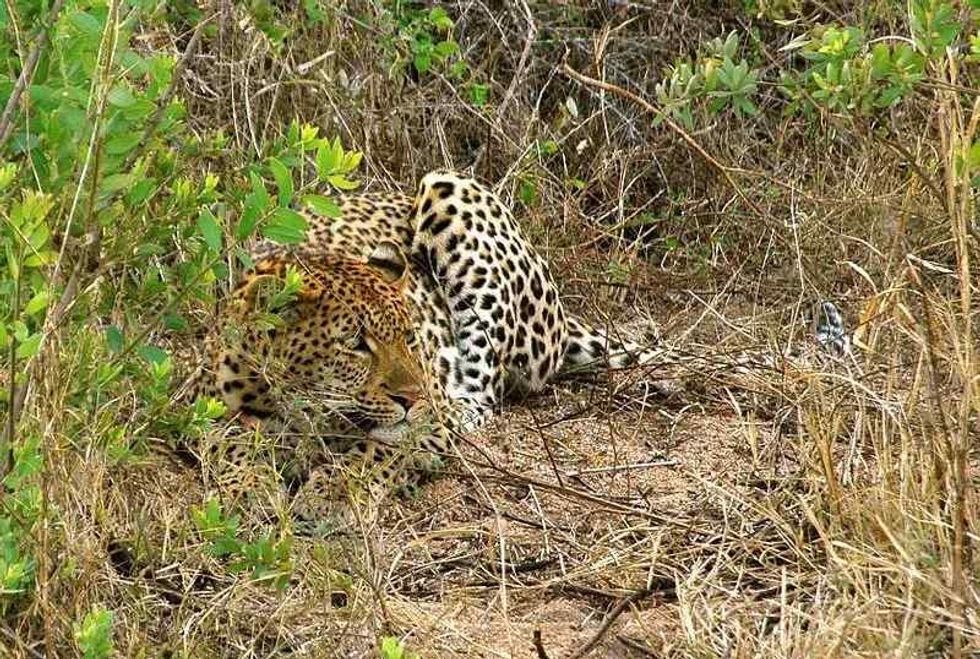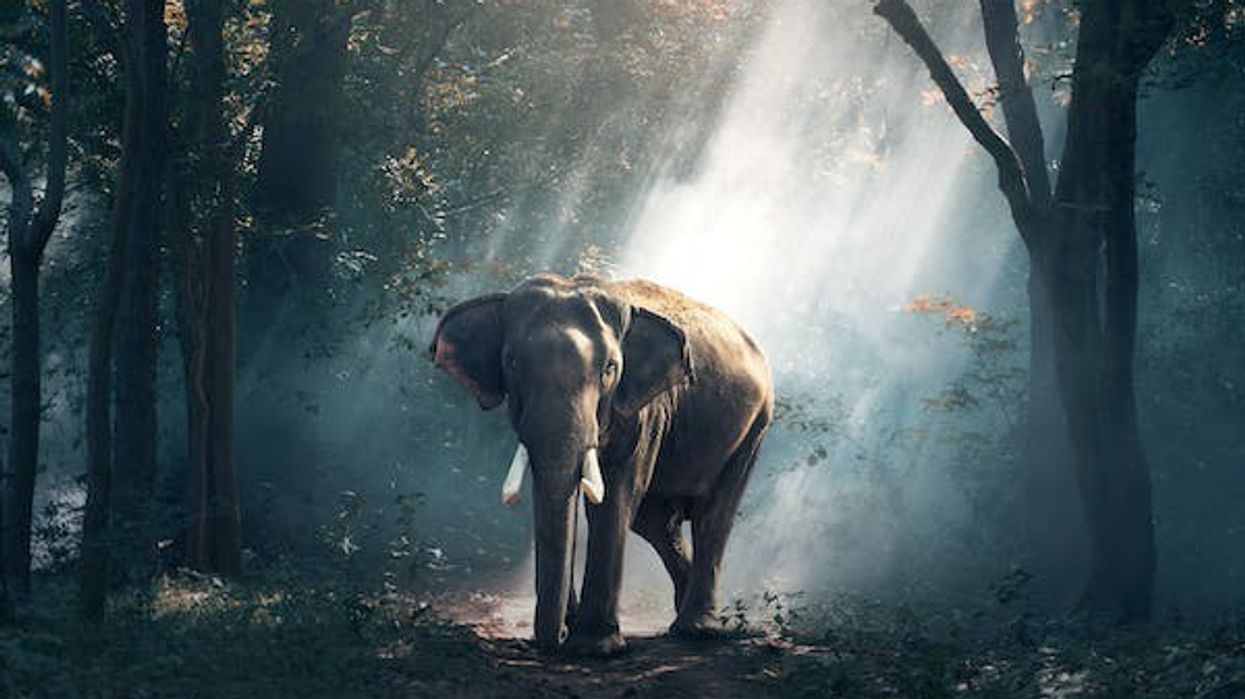Do you consider yourself to be a cat person?
If yes, then you would absolutely love the magnificent African leopard (Panthera pardus pardus). These majestic creatures can be found roaming in the savannah regions of Sub-Saharan Africa.
Big cats like African leopards are a sight for sore eyes and are often considered to be a favorite in the circles of animal photographers.
However, it's still rare to spot one since leopards are arboreal creatures which means that they love staying hidden in trees where they can be seen munching on small arthropods. When these leopards get really hungry, they can be seen hunting for big animals like deer or antelope!
These big cats love to climb trees but over the last few years, due to human activities, like mining, there has been a loss of habitat for the leopard (Panthera pardus) which has caused the population of this species to decline.
If you like reading animal facts like this one, be sure to check out Arabian leopard facts or paint horse facts.
African Leopard Interesting Facts
What type of animal is an African leopard?
African leopards are big cats that belong to the family of Felidae and the sub-family of Pantherinae. They are distinguished from other similar species of leopards by their trinomial scientific name Panthera pardus pardus.
These leopards are shy but fierce animals and they are often seen making the biggest of antelopes their prey quite easily! These leopards are mainly found in savannahs of countries in southern Africa.
What class of animal does an African leopard belong to?
Just like all of the other feline species, the African leopard is a mammal. Hence, they belong to the class of Mammalia. These cats are seen giving birth to two or three cubs in the wild and these leopard cubs are one of the cutest creatures you might have ever seen.
How many African leopards are there in the world?
There exist around nine subspecies of leopards that are recognized by the IUCN. One of these nine species is the African leopard species.
According to various studies and research that has been conducted in the past, it is estimated that there may be around 12000-14000 African leopards in the wild regions of southern Africa. Studies also say that there may still be more of these leopards widely distributed over various other parts of Africa.
The IUCN has categorized the African species of leopards to be Vulnerable.
Where does an African leopard live?
African leopards, like most of the other leopard species, happen to be arboreal in nature. These cats love to stay on trees and prey on small arthropods or, even hunt the bigger animals found in Africa such as the antelopes.
Hence, these leopards are the savannah regions of Africa where there are quite a few trees to climb on and also long stretches of patchy desert-type lands where these cats can hunt freely. They have been sighted in various counties across Africa, mainly in Ethiopia, Liberia, Egypt, and Morocco.
What is an African leopard‘s habitat?
Just like the leopard (Panthera pardus), the African leopard loves a habitat where it can hunt freely and also has the safety of living on trees, away from much bigger cats. Hence, these cats are found mostly in arid desert or savannah regions of Africa.
In some cases, the leopard can also be seen living in tropical rainforest areas. This may happen because of various factors such as the diet of the leopard, habitat loss, abundance of animals to prey on, etc.
Who do African leopards live with?
African leopards like their space and prefer to live and hunt on their own. However, they are seen with other leopards typically during the mating period or while raising the young cubs.
The leopard cubs are eventually left alone when they grow enough to hunt on their own. Studies have shown that leopards can lead peaceful lives coexisting with animals like the lion but, research conducted at the Kruger national park found that around 20% of the leopard's fatality rate in the park was caused by the lion pride.
How long does an African leopard live?
The African leopard (Panthera pardus pardus) can live anywhere between 10-12 years in the wild depending on factors such as the availability of prey and habitat. It is seen that in captivity, the leopard can grow almost up to 23 years!
How do they reproduce?
African leopards, like most other feline species, tend to mate throughout the year. However, they are most active usually during the springtime when the female comes into heat. Female leopards release pheromones in order to attract males.
The period of copulation can range anywhere between three to six seconds with various intervals. This can last for days. The gestation period of the African leopards can range anywhere between three to four months after which the female leopard births around two or three cubs.
What is their conservation status?
Like the leopard (Panthera pardus), the conversation status of the African leopard has been listed as Vulnerable by the IUCN. Human activities such as mining have resulted in a loss of habitat for these animals which has rendered the population of African leopards, endangered in some regions.
African Leopard Fun Facts
What do African leopards look like?
African leopards are beautiful and majestic creatures. They have a furry pale yellow coat covered with black spots.
In some cases, their coat can even resemble a tawny shade or a golden shade. These leopards are predators and have hard skulls with strong jaws and sharp teeth. They have sharp nails on their claws and also have a long tail which can range anywhere between 3.5-4 ft ( 1-1.2 m).
How cute are they?
These leopards are magnificent creatures and their beauty is captivating. Their coat looks golden in color while it shines in the sun.
The cubs of these leopards are the cutest feline cubs one might ever come across. They have cute little paws and they really love being naughty. They can often be seen purring and sleeping, or playing with other cubs.
How do they communicate?
Leopards communicate with each other using various methods. If they want to make another male aware of their presence, they make a raspy coughing-type sound. They can also be seen growling and hissing when confronting their prey or trying to defend themselves from threats. When these leopards are happy they make a purring noise which is extremely cute!
How big is an African leopard?
African leopards are much bigger than the typical house cat. They have a strong thick skull which may range around 11 in (28 cm) in length and 7 in (18 cm) in breadth.
The bodies of these leopards ranges around 4.25-6.25 ft (1.3-1.9 m) in length and they can grow as tall as 22-28 in (56-72 cm) in height.
These animals are sexually dimorphic and the males are much bigger than females. The availability of food to prey on may also be one of the factors which might affect the size of these cats.
How fast can an African leopard run?
Leopards are extremely fast as the muscles in their legs are very strong and developed. This gives these animals the ability to perform various feats that many other felines could never possibly achieve.
In the wild, these leopards can clock at a speed of about 36 mph (58 kph)!
However, these animals cannot keep up this speed for a long time, and usually, they only take short sprints at this speed which may cover only a distance of about 650 ft (200 m).
These leopards can also be seen using their strong legs to jump as high as around 10 ft (3 m) vertically or 20 ft (6 m) horizontally which just heightens their hunting capabilities.
How much does an African leopard weigh?
Being dimorphic in nature, there is a significant weight difference between the male and female leopards of this species. The average weight of the male leopard is around 130 lb (60 kg), while the average weight of the female leopard is around 77-86 lb (35-40 kg).
The largest-ever leopard of this species was found in Africa a few years ago, it weighed somewhere around 200 lb (91 kg).
What are the male and female names of the species?
There are no sex-specific names for African leopards.
What would you call a baby African leopard?
Their babies are referred to as cubs.
What do they eat?
These cats love to prey on anything they can find, they don't really have a specific preference when it comes to food and can be seen eat almost anything a carnivore would. Since they are arboreal, they sometimes make insects like the dung beetle their prey.
However, just because these animals are seen eating insects sometimes, we cannot underestimate these fierce creatures. They can easily hunt much bigger animals than them such as antelopes or even deer.
Due to the amazing power packed in their legs, they can jump high enough to catch birds that are flying low and make them their food! African leopards eat other animals like hyrax, rodents, hares, and many other smaller creatures.
Would they make a good pet?
These animals belong in the wild and are not meant to be kept as pets as their predatory instincts may cause an issue of concern. However, It isn't exactly illegal to have exotic animals like leopards as pets in the United States.
Only 19 of the 50 states have banned the ownership of exotic animals as pets.
It's still legal to get one in the other parts of the country by paying heed to the laws and regulations of owning one. It is also noticed that in captivity, these animals can grow up to live for about 23-25 years.
Did you know...
Due to melanism, the fur of some of these leopards becomes completely black in color, enough for people to confuse them for panthers. However, the sighting of these black leopards happens to be quite rare in Africa.
The African leopard population used to be widely spread around the southern parts of Africa, however, due to overhunting and the loss of the African leopard habitat, they can now be found all over the continent of Africa.
Leopards are dangerous creatures and are often found near human settlements raiding livestock, unlike lions which tend to calm down when they are stared at, these creatures get extremely hostile and hence it's advised to not stare one directly in the eye in case of confrontation.
The African leopard speed is almost half the speed of a cheetah which has been clocked at 70 mph (112 kph)!
These big cats are widely distributed in the arid desert regions of sub-Saharan Africa.
Are African leopards endangered?
The IUCN has listed the population of African leopards as Vulnerable.
How much space does an African leopard need?
These big cats need enough space to hunt and roam freely and hence they prefer living in arid desert places where there's enough land to hunt and roam across.
Here at Kidadl, we have carefully created lots of interesting family-friendly animal facts for everyone to discover! Learn about some interesting cats from our Javan leopard facts and Bengal tiger facts pages.
You can even occupy yourself at home by coloring in one of our free printable Persian leopard coloring pages.









